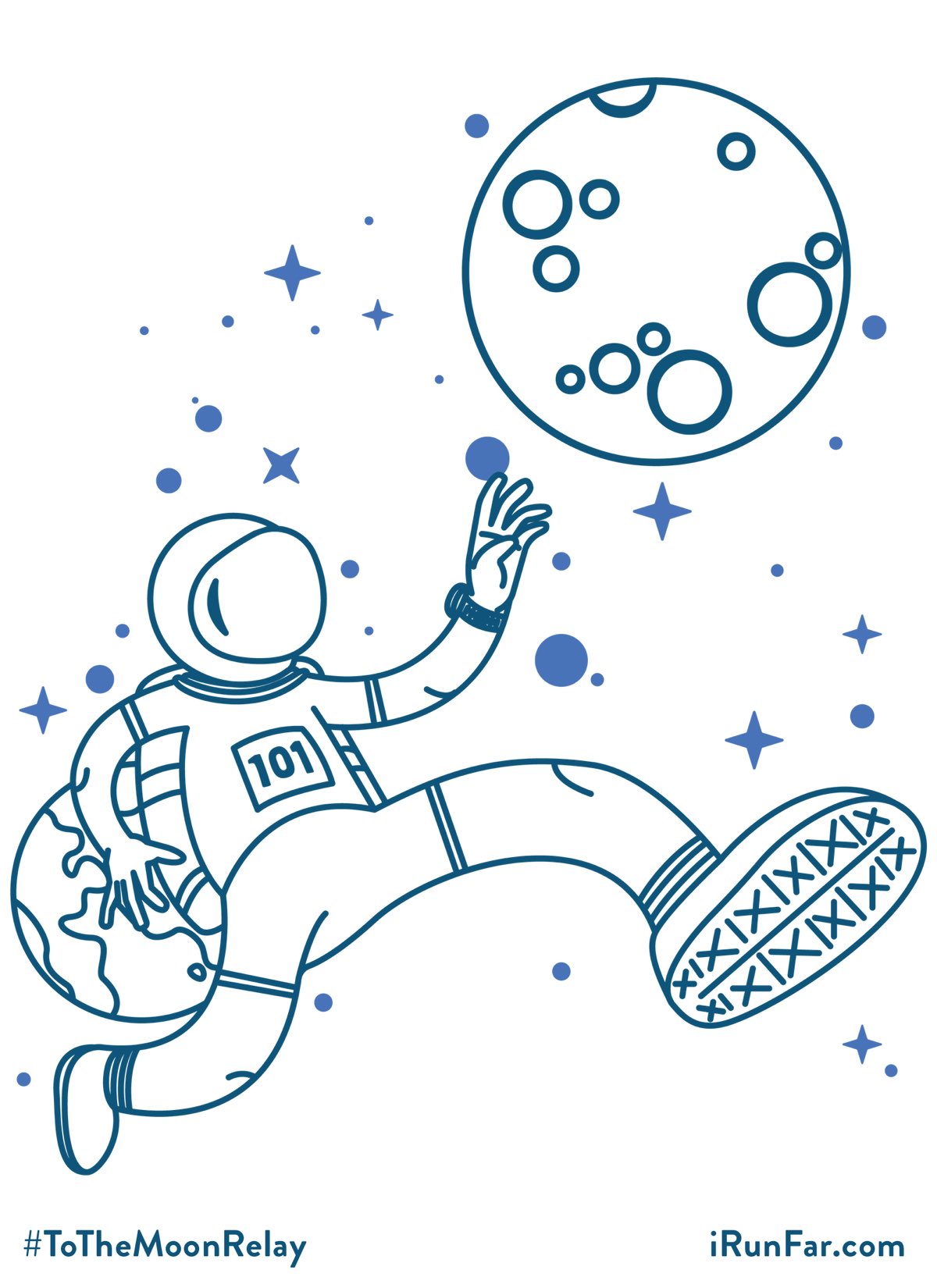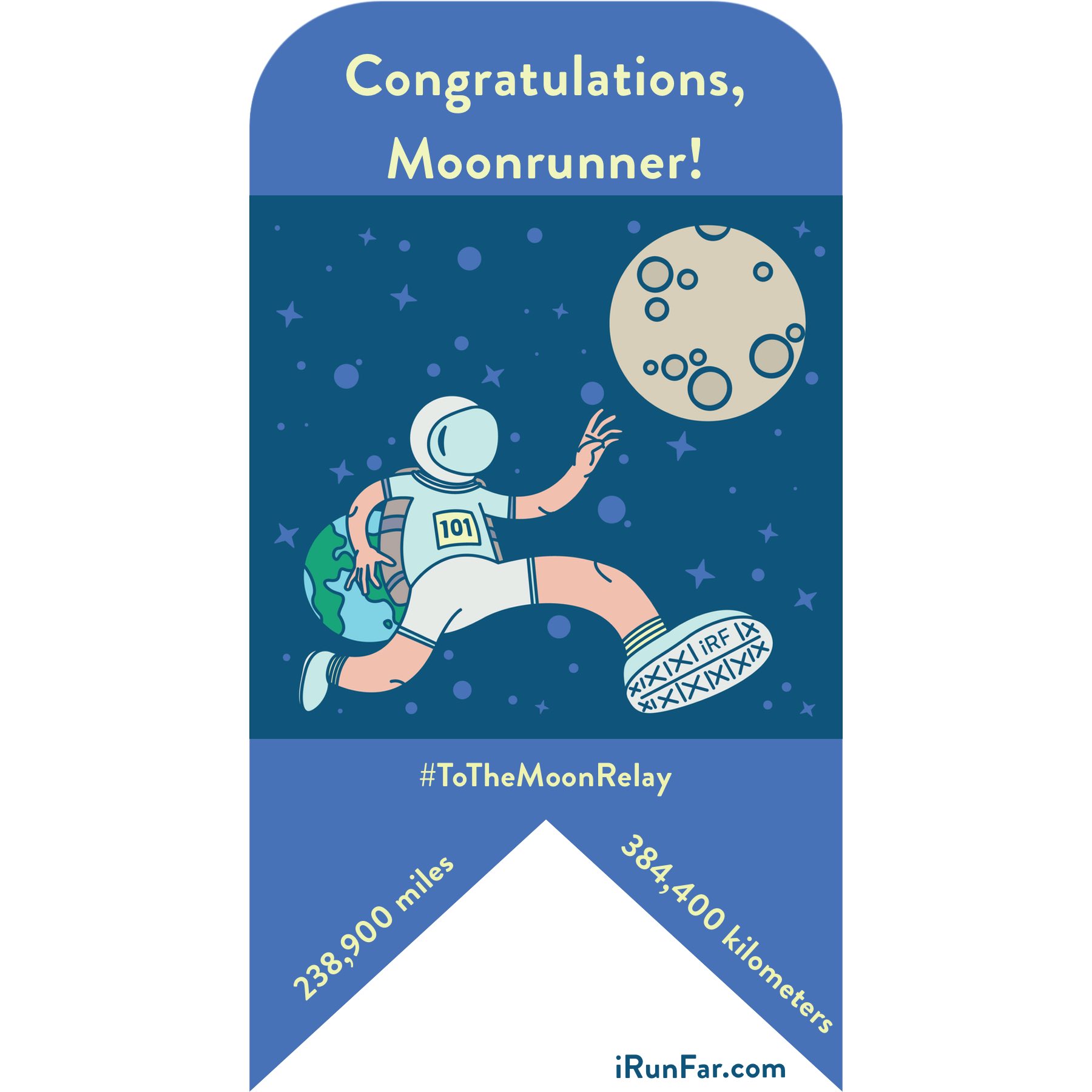[maxbutton id=”8″][maxbutton id=”3″][maxbutton id=”4″]
Moonrunner Kids Activities
We hope these seven activities will help you learn about the Moon and enjoy the To The Moon Virtual Relay!
Register now – it’s FREE!
There’s one activity for each of the relay’s seven days, but we encourage you to complete them at your own pace. However, if you can, save Activity 7 for the relay’s last day when there’s a full Moon!
Share your efforts on your favorite social media! Tag iRunFar and use #ToTheMoonRelay so other participants can see you. We’re on Facebook, Twitter, and Instagram and will be watching for you, too!
When you complete all seven activities, be sure to download the Moonrunner Badge.
Click here to download the Moonrunner Kids Activity Packet as a PDF or enjoy the activities here on this page.
Activity 1: Walk to the Moon
Let’s walk to the Moon! Just kidding, that’s really, really far–238,900 miles (384,400 kilometers). On this walk, we’ll scale down that huge space to a distance you can walk near your home–1 mile (1.6 km).
- Choose a 1-mile (1.6 km) route and make sure you know its halfway point, too. Have fun planning this ahead of time.
- At your starting point, pretend you are standing on the Earth. It’s time to head for space!
- Leave Earth by taking 5 steps. In our scaled walk to the Moon, can you guess how many of the 238,900 miles (384,400 km) we’ve now traveled? We’ve gone 452 miles (727 km) and we are already in the outer layer of the Earth’s atmosphere, the Exosphere. We’ve already passed by all of the tallest mountaintops, all the clouds, and every airplane flying around the Earth. Out here is where satellites and the International Space Station fly!
- Take 63 more steps. Now we’ve traveled 6,200 miles (10,000 km) and have totally left the Earth’s atmosphere. We’ve gone far, but we have so far to go!
- Walk to the halfway point of your mile walk, imagining that you are in space. Behind you, the Earth starts to get smaller, and in front of you the Moon gets bigger. When you get to the halfway point, imagine yourself looking forward toward the Moon and backward toward the Earth as they are equal distances away from you. Also, imagine the cold and dark of space.
- It’s time to walk the rest of your mile. As you do, think about the astronauts on the Apollo 11 spacecraft which traveled from the Earth to the Moon so that its astronauts could walk on and observe the Moon for the first time in 1969. It took them about 3 days in their spacecraft to make the journey. How long does this take you, maybe 20 or 30 minutes?
- As you approach the end of your mile, make your Moon landing! Imagine what the surface of the Moon might look and feel like as you touch down.
Activity 2: Be a Crater Maker
We’re sure you’ve noticed the darker circles and shapes on the Moon. These are craters, or giant divots made in the Moon’s surface by asteroids and comets when they come from space and hit the Moon. In this activity, we’ll make the Moon and its craters.
Here are the supplies you need:
- 4 cups of flour
- 1/2 cup of baby oil or cooking oil
- A few pebbles about 1 inch (2 centimeters) in diameter
- Round cake pan
- Mix the flour and oil together, and then shape your dough into the round cake pan to create your Moon surface.
- Place your Moon on the ground, and then drop the pebbles onto it from several feet above, imagining each pebble is an asteroid or comet heading for the Moon’s surface.
- Remove the pebbles to see the craters left by your asteroids and comets.
Activity 3: Learn the Moon Phases
Why does the Moon look like a sliver on some nights, a half circle on others, and a full circle once in a while? That’s because the Moon has phases.
The Moon does not create its own light. Instead, like the other objects in our Solar System including the Earth, it reflects the Sun’s light. Over the course of a little less than a month, the Moon orbits around the Earth one time, and its orientation relative to the Earth causes more or less sunlight to be reflected off of it and to create its phases.
Note that these instructions create the Moon phases as seen in the Northern Hemisphere. If you live in the Southern Hemisphere, your Moon phases will look a little different. Here’s a link with images of the moon phases in both hemispheres.
Here are the supplies you need:
- 2 pieces of paper of a light/white color and a dark/black color
- Scissors
- Pencil
- Bowl
- Draw a circle on each piece of paper using the bowl as your guide. Cut out each circle.
- Begin with the Moon phase called the New Moon by entirely covering your light circle with the dark circle on top of it. This is when we on Earth can’t see any sunlight reflected on the Moon.
- Move the dark circle a little to the left to reveal a sliver of the light circle on the right side. This is called the Waxing Crescent phase.
- Now, move the dark circle to the left so that it uncovers half of the light circle on the right. This is the First Quarter phase.
- Next up is the Waxing Gibbous phase where you move the dark circle to the left so that about 3/4 of the light circle is visible on the right.
- The Full Moon phase is when the light circle is totally uncovered. We are halfway through the phases now!
- Now, move the dark circle so just a small part of the right side of the light circle is covered. This is the Waning Gibbous phase.
- Move the dark circle left so it covers half the light circle. This is the Third Quarter phase.
- Move into the Waning Crescent phase by shifting the dark circle to the left so only a sliver of the light circle is visible on the left side.
- Return to the New Moon phase where the dark circle entirely covers the light circle. Almost a month has gone by and the phases start over again!
Activity 4: Write or Tell a Story About the Moon
Use your imagination to either write or tell a story about the Moon! Adventure, mystery, truth, or fiction, let your mind have fun and create whatever story you like.
Activity 5: Go for a Moonrun
Let’s go for a Moonrun to learn about gravity. First, search on the internet for videos of astronauts walking, jogging, working, and occasionally falling down on the Moon. It’s so fun–and sometimes funny–to watch! You might notice how differently they move than how we move here on Earth. It almost looks like they are moving in slow motion and floating a little each time they take a step. Why is that?
When we walk on Earth or when astronauts walk on the Moon, we are all being “pulled” toward the ground by gravity. The amount of that pull is related to the mass of the Earth and the Moon. The Moon is only about 1/6 the mass of the Earth–a lot smaller!–which means it exerts just 1/6 of the gravity on whatever’s on its surface compared to the Earth. That’s why it’s so different to walk to on the Moon!
Now it’s time to go for your own Moonrun. First you’ll need a space suit, something that protects you from the conditions in space–very cold temperatures, darkness, and no oxygen to breathe! Get creative in using things around your house to create your suit. Snorkel? Snowsuit? Bike helmet? Ski gloves? Flashlight?
Next, head into your backyard or neighborhood for your Moonrun. Imagine what it might feel like to move with less gravity or downward pull on you. Do a little slow-motion running, bounding, or whatever you like while pretending that you are on the Moon with the astronauts!
(Adults, you know you want to try this, too. Bonus points for posting photos and videos to social media!)
Activity 6: Color the Moonrunner
Click here to download the Moonrunner coloring page as a JPG file to print and color. Alternately, download the coloring page as a PNG file to color on your device of choice. :-)
Activity 7: Take a Moonlight Hike
Our final activity is the Moonlight Hike. If you can, do this on the final day of the To The Moon Virtual Relay, July 5, the day of a full Moon! The Moon will rise around sunset, be really visible (unless it’s cloudy), and give you a chance to see its features.
Grab your family, your flashlight, binoculars if you have them, maybe your dog and a jacket, and take a hike under the Moon! You can hike a little or a long ways, in your neighborhood or maybe at the park, wherever and however you want to adventure.
Make sure to look up at the Moon and talk about what you’ve learned in the other activities. See if you can answer these challenge questions on your hike:
- How many miles (or kilometers) is it between the Earth and the Moon?
- Why does the Moon have craters, or the dark circles and other shapes on its surface?
- What are the phases of the Moon and why does the Moon sometimes look like a sliver, a half, or a full Moon?
- Is there more or less gravity on the Moon compared to the Earth and what might it look and feel like to walk on the Moon compared to the Earth?
- What has been your favorite part of learning about the Moon this week?
Congratulations!
Congratulations on completing the Moonrunner Kids Activities. You’re a Moonrunner! Click here to download the Moonrunner Badge.
Credits
Thank you to ”I Can Teach My Child” for the Moon recipe and crater-making idea. Thanks to Liza Howard, Gabe and Jenny Joyes, and Eva McKenna-Tramontana for helping to ideate these activities.



